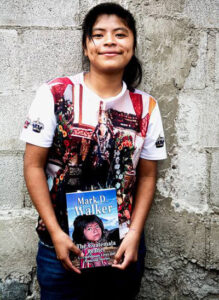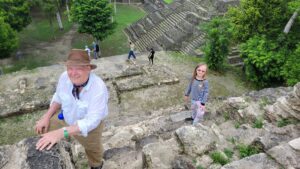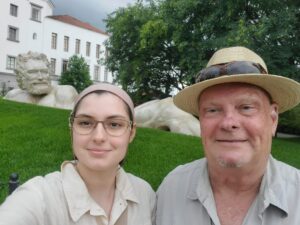
Dear Friends and Colleagues from Around the World,
I returned from a three-week trek through Guatemala with my wife, son, daughter-in-law, and two granddaughters. The first of many surprises relates to the Indigenous girl on the cover of The Guatemala Reader. I’ll share some of the beauty I saw in The Land of the Eternal Spring. In Culture Watch, I’ll highlight some of the devastating effects of climate degradation, the impact of immigration, and an updated Calendar.

During my visit to Guatemala, I planned to visit several friends and contacts. On one of those visits, I hand-carried a copy of The Guatemala Reader to the photographer who took the picture of the young Indigenous girl on the cover. Cliff retired to Lake Atitlan some ten years ago, and I met him through his brother, with whom I worked with him at Carlton & Co, including a client in Guatemala.
Our lunch at the Atitlan Hotel was my first meeting with him. Much to my surprise, Cliff took the book to show the girl on the cover, who was six years old. This brings back images of the young girl with green eyes who became famous when she appeared on the cover of National Geographic. In this case, the photographer tracked her down in Santa Catarina Popolo on Lake Atitlan, and she was thrilled when she saw the cover and hugged the photographer, Cliff, creating yet another “amazing” story.
My wife Ligia and I celebrated our 51st wedding anniversary in Guatemala on June 23d, and we intend to begin introducing our eight grandchildren to the Land of the Eternal Spring and its diverse culture. We also wanted to introduce them to their cousins and family members, which was accomplished when over 50 attended our “family reunion.”
On this trip, we spent much of our time in the Capital, Antigua, San Juan Comalapa, Flores, Tikal, San Jeronimo, Coban and Lake Atitlan

Climbing to the top of one of Tikal’s Temples with our eight-year-old granddaughter was worth it, and the views from the Hotel Toliman on Lake Atitlan were breathtaking.
Culture Watch
We visited the “futuristic” community of Cayalá in Guatemala City with our 22-year-old granddaughter. Guatemala’s middle and upper classes were concentrated in one place, and Mishi was not impressed by the European design. She said she felt like Americans designed it on a European theme.

In fact, this new Utopian enclave is a testament to inequality: The development of Cayalá is a romantic, serene, and prizewinning place as well as an elite stronghold in one of Latin America’s most unequal nations; it is also divisive and reflects serious challenges of social justice in Guatemala.
Guatemalan award-winning filmmaker Luis Argueta, on of the “Extraordinary Lives,” in my book, sent me this article explaining why we felt ill at ease there.

As we flew over the Peten, you could see the damage: 123,000 acres destroyed by man to expand agriculture (especially palm oil plantations) and cattle grazing. Guatemala has the worst rate of environmental degradation in the Americas (see the index at the end of The Guatemala Reader). A headline in the local newspaper, “Mayan Jungle Damaged by Fires,” confirmed this situation.
The other environmental wake-up call was in the middle of Lake Atitlan, the deepest lake in Central America. The pilot of our launch had to stop several times to maneuver in and around several massive slicks of debris and plastic. Evidently, people feel it’s acceptable to toss whatever bottles or plastic containers they have into the lake.
Another eye-opener was our visit to the quaint village of Santiago. I wanted our granddaughters to be aware of the priest from Oklahoma, Stanley Rother, who was martyred there by the Guatemalan military during the violent Civil War. A high percentage of the population felt compelled to leave for a better life in the U.S. and are now sending millions of dollars home in the form of remittances. Consequently, the town is now dominated by multi-story, unfinished buildings that create a surreal landscape next to this spectacular lake.

SEEDS for a Future
One of my few business-related activities was a meeting with the Operations Director, Leilani of SEEDS, for an orientation to join their board. I’ve known Earl and Suzanne, the founders for many years and even profiled them in my book, “Allegro to Guatemala: An Expatriate Journey Through the Land of Eternal Spring.” They set the group up in 2007 to provide affordable and sustainable training for impoverished rural women in the community of Chocolá on the South Coast. I’ll be reporting on their work as I learn more. https://seedsforafuture.org/
Calendar
- October 10-12: at ASU Desert Nights, Rising Stars Writers Conference,

You can find my 80 book reviews and 28 articles, plus several videos and photos, on my website, including a reduced price for my new book if you read it and pass it along to your local library: http://millionmilewalker.com. “Follow” me on Twitter—at https://twitter.com/millionmile and Facebook at https://www.facebook.com/millionmilewalker/ for the latest international affairs and literature.
And, as always, if you’ve read “Different Latitudes: My Life in the Peace Corps and Beyond, My Saddest Pleasures: 50 Years on the Road, the Best Travel Book according to the Peace Corps Writers, and of course, my most recent book, The Guatemala Reader, please review and rate them on Amazon and Goodreads.
Shalom!
Mark D. Walker